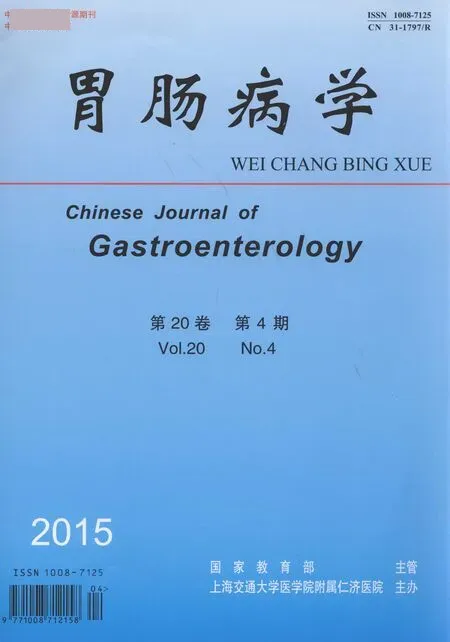糖基化终末产物在糖尿病胃肠动力中的作用及其机制
朱 滢 林 琳 朱海杭
江苏省苏北人民医院消化科1(225001) 南京医科大学第一附属医院消化科2
糖基化终末产物在糖尿病胃肠动力中的作用及其机制
朱滢1*林琳2朱海杭1#
江苏省苏北人民医院消化科1(225001)南京医科大学第一附属医院消化科2

糖尿病(diabetes mellitus, DM)几乎可影响消化道所有部位,约75%的DM患者伴有胃肠动力障碍,常见症状有恶心、呕吐、吞咽困难、反流、腹泻、腹痛、便秘等[1]。尽管DM胃肠动力障碍的确切机制仍不清楚,但自主神经病变为其潜在机制的观点已被广泛接受,并且越来越多的证据表明,其他病理生理因素亦在其中发挥重要作用,如平滑肌病变、Cajal间质细胞病变、肠神经系统病变等[1-3]。此外,DM胃肠动力障碍可能还与肠道菌群、肠道免疫等有关,但尚待进一步证实。文献报道糖基化终末产物(advanced glycation end products, AGEs)在DM患者血清和各组织器官中的含量较正常人明显升高,可通过氧化应激、糖基化修饰某些蛋白等,在DM并发症的发生、发展中起重要作用[4]。目前AGEs在DM并发症中作用的研究主要集中于DM肾病、DM血管病变方面,其与DM胃肠动力障碍的相关性少见报道。本文对AGEs在DM胃肠动力中的作用及其可能机制作一综述。
一、AGEs及其受体和非受体依赖性作用机制
AGEs是体内由蛋白质、脂质或核酸等大分子物质经非酶促反应与葡萄糖或其他还原单糖反应生成的稳定共价化合物,该过程称为非酶糖基化反应[5]。AGEs的形成是一个非常复杂的级联反应过程,DM时的高糖环境可促进其形成,具体机制尚未完全明确。由于AGEs是一类复杂的异构化合物的总称,因此须采用不同方法进行检测[6]。AGEs对机体不同部位、不同类型细胞的影响不尽相同,作为DM并发症的重要病理基础,其可能参与了DM胃肠道并发症的发生。
生理情况下,AGEs的产生和清除处于平衡状态,如产生超过清除,将引发多种疾病,如DM慢性并发症、衰老、动脉粥样硬化、高血压、阿尔茨海默病、肿瘤等。AGEs蓄积于细胞和基质,通过受体依赖性和非受体依赖性途径参与病理反应。受体依赖性途径系通过特定的细胞表面受体调节细胞功能,非受体依赖性途径则系通过糖基化蛋白的蓄积改变细胞外基质结构等发挥作用[7-10]。RAGE(receptor for advanced glycation end products)是首个被描述的AGEs受体,其为一种多配体受体,是免疫球蛋白超家族成员,存在于平滑肌细胞、巨噬细胞、内皮细胞和星形胶质细胞表面。RAGE由3个胞外结构域构成,包括一个V型的具有配体结合特性的结构域和两个C型的免疫球蛋白结构域。AGEs绑定至V型结构域,产生持续的受体依赖性信号,介导细胞活化,导致炎症反应,最终改变组织细胞功能[11-12]。AGEs/RAGE系统被认为是引起DM并发症的重要病理机制之一,参与DM心血管疾病、视网膜病变、肾病等的发生[13-15]。除与RAGE结合激活细胞内信号转导途径外,AGEs还可通过修饰细胞外蛋白的结构和功能发挥作用。糖基化蛋白的结构对降解更为耐受,交联产物蓄积于细胞和组织间,参与器官和血管功能障碍的形成;此外,糖基化蛋白还可通过破坏正常蛋白的分子构象改变酶活性以及干扰配体与受体的识别等[16]。
二、AGEs与DM胃肠动力障碍
1. AGEs在胃肠道自主神经中的分布及其作用:多项研究表明DM患者存在胃肠慢传输和蠕动异常,DM自主神经病变被认为是引起胃肠运动和感觉功能障碍的主要原因之一[17]。鉴于AGEs对各组织器官均有影响,因此推测其参与了DM胃肠动力障碍的发生、发展。非DM、DM个体和动物模型的整个中枢和周围神经系统均可检出AGEs,包括神经元、轴突、Schwann细胞、血管内皮细胞、周细胞、基底膜等,RAGE则分布于整个中枢和周围神经系统的神经轴[18]。AGEs的蓄积一方面直接影响蛋白结构和功能,另一方面通过结合RAGE间接发挥功能,后者在DM神经病变的发生、发展中起重要作用[19]。Jeyabal等[20]的研究显示,胃肠道神经元表达神经元型一氧化氮合酶(nNOS),诱导产生一氧化氮(NO),NO是调节胃肠运动的关键抑制性神经递质,而AGEs能抑制肠道nNOS,从而抑制NO产生;在DM大鼠模型中,AGEs抑制剂 ALT-711可阻止肠神经元nNOS缺失,进而维持NO产生,以调节胃肠运动功能。Toth等[21]的研究证据表明,大量RAGE在神经元轴突和神经胶质细胞的表达参与了DM对称性感觉运动多发性神经病变的信号转导过程。Chen等[22]对DM大鼠模型的研究发现,AGEs和RAGE在小肠和结肠肌间神经丛和黏膜下神经丛蓄积,两者含量均明显增多。上述研究证据表明,AGEs/RAGE系统似在DM胃肠自主神经病变中起重要作用。
2. AGEs在胃肠道肌层的分布及其作用:AGEs在上皮细胞、平滑肌细胞、肌间和黏膜下神经丛神经元中呈均匀分布,RAGE主要分布于上皮细胞和神经元细胞膜,正常平滑肌细胞未观察到RAGE阳性染色。AGEs在肌层蓄积以及神经节RAGE表达增加可能参与了DM小肠和结直肠运动障碍的发生、发展[23]。Chen等[22]的研究表明,DM大鼠模型回肠环肌层、纵肌层增厚,绒毛、隐窝、环肌层AGEs和RAGE表达显著上调,可能影响小肠平滑肌的收缩特性。在其他组织器官如肾脏中,AGEs可通过激活RAGE导致上皮细胞向肌成纤维细胞转分化,引起组织纤维化[24],由此推测AGEs亦可能引起胃肠组织纤维化,进而影响胃肠运动功能。但目前尚无实验证据支持AGEs/RAGE系统可促进胃肠组织纤维化,该假设有待进一步研究证实。
3. AGEs在胃肠道黏膜的分布及其作用:众所周知,小肠上皮细胞在食物的消化、吸收中起重要作用。刷状缘是小肠消化和运输过程中的重要位点,多种位于小肠微绒毛刷状缘的酶类参与了碳水化合物和肽类的消化,如乳糖酶、 蔗糖酶、麦芽糖酶、α-糊精酶等。Chen等[22]的研究显示,AGEs在空肠、回肠微绒毛和隐窝蓄积以及RAGE表达增加可能参与DM小肠消化和吸收功能障碍。DM时小肠上皮细胞微绒毛膜脂质流动性降低[25],膜的流动性可改变刷状缘消化酶活性,因此AGEs可能通过影响细胞膜特性,导致小肠微绒毛膜流动性降低,进而影响小肠吸收功能。已证明RAGE能激活多种细胞内信号级联反应,诱导肠上皮细胞功能改变[26],AGEs/RAGE系统在DM胃肠道黏膜病变中的机制及其与DM胃肠动力障碍间是否存在直接联系,尚需进一步研究。
三、总结与展望
综上所述,AGEs异常蓄积在DM并发症的发生、发展中起重要作用,但其参与DM胃肠动力障碍的具体机制尚未完全明确,关于AGEs与DM胃肠动力有以下问题亟待解决:AGEs和RAGE在胃肠道内的分布及其作用;内源性AGEs对胃肠动力的直接影响;胞内第二信使信号通路、离子通道等在AGEs抑制胃肠动力中的作用等。上述问题的研究和解决,不仅对完善胃肠运动调节机制的认知具有重要意义,而且可能为胃食管反流、便秘等DM相关胃肠动力障碍症状的治疗提供新的靶点。
参考文献
1 Yarandi SS, Srinivasan S. Diabetic gastrointestinal motility disorders and the role of enteric nervous system: Current status and future directions[J]. Neurogastroenterol Motil, 2014, 26 (5): 611-624.
2 Wang Y, Xu XY, Tang YR, et al. Effect of endogenous insulin-like growth factor and stem cell factor on diabetic colonic dysmotility[J]. World J Gastroenterol, 2013, 19 (21): 3324-3331.
3 Bagyanszki M, Bodi N. Diabetes-related alterations in the enteric nervous system and its microenvironment[J]. World J Diabetes, 2012, 3 (5): 80-93.
4 Wei Q, Ren X, Jiang Y, et al. Advanced glycation end products accelerate rat vascular calcification through RAGE/oxidative stress[J]. BMC Cardiovasc Disord, 2013, 13: 13.
5 Arsov S, Graaff R, van Oeveren W, et al. Advanced glycation end-products and skin autofluorescence in end-stage renal disease: a review[J]. Clin Chem Lab Med, 2014, 52 (1): 11-20.
6 Yamagishi S. Role of advanced glycation end products (AGE) and soluble receptor for AGE (sRAGE) in vascular complications in diabetes[J]. Nihon Rinsho, 2012, 70 Suppl 5: 243-247.
7 Park SY, Kim YA, Hong YH, et al. Up-regulation of the receptor for advanced glycation end products in the skin biopsy specimens of patients with severe diabetic neuropathy[J]. J Clin Neurol, 2014, 10 (4): 334-341.
8 牛轶雯,缪明远,董炜,等. 晚期糖基化终末产物与其受体对糖尿病创面氧化应激反应的影响[J]. 中华烧伤杂志, 2012, 28 (1): 32-35.
9 Kalousova M, Zima T. AGEs and RAGE - advanced glycation end-products and their receptor in questions and answers[J]. Vnitr Lek, 2014, 60 (9): 720-724.
10Fukami K, Yamagishi S, Okuda S. Role of AGEs-RAGE system in cardiovascular disease[J]. Curr Pharm Des, 2014, 20 (14): 2395-2402.
11Zhu P, Ren M, Yang C, et al. Involvement of RAGE, MAPK and NF-kappaB pathways in AGEs-induced MMP-9 activation in HaCaT keratinocytes[J]. Exp Dermatol, 2012, 21 (2): 123-129.
12Kierdorf K, Fritz G. RAGE regulation and signaling in inflammation and beyond[J]. J Leukoc Biol, 2013, 94 (1): 55-68.
13Prasad A, Bekker P, Tsimikas S. Advanced glycation end products and diabetic cardiovascular disease[J]. Cardiol Rev, 2012, 20 (4): 177-183.
14Chen M, Curtis TM, Stitt AW. Advanced glycation end products and diabetic retinopathy[J]. Curr Med Chem, 2013, 20 (26): 3234-3240.
15Ishibashi Y, Yamagishi S, Matsui T, et al. Pravastatin inhibits advanced glycation end products (AGEs)-induced proximal tubular cell apoptosis and injury by reducing receptor for AGEs (RAGE) level[J]. Metabolism, 2012, 61 (8): 1067-1072.
16Zhao Z, Liu J, Shi B, et al. Advanced glycation end product (AGE) modified proteins in tears of diabetic patients[J]. Mol Vis, 2010, 16: 1576-1584.
17Chandrasekharan B, Anitha M, Blatt R, et al. Colonic motor dysfunction in human diabetes is associated with enteric neuronal loss and increased oxidative stress[J]. Neurogastroenterol Motil, 2011, 23 (2): 131-138, e126.
18King RH. The role of glycation in the pathogenesis of diabetic polyneuropathy[J]. Mol Pathol, 2001, 54 (6): 400-408.
19Singh VP, Bali A, Singh N, et al. Advanced glycation end products and diabetic complications[J]. Korean J Physiol Pharmacol, 2014, 18 (1): 1-14.
20Jeyabal PV, Kumar R, Gangula PR, et al. Inhibitors of advanced glycation end-products prevent loss of enteric neuronal nitric oxide synthase in diabetic rats[J]. Neurogastroenterol Motil, 2008, 20 (3): 253-261.
21Toth C, Rong LL, Yang C, et al. Receptor for advanced glycation end products (RAGEs) and experimental diabetic neuropathy[J]. Diabetes, 2008, 57 (4): 1002-1017.
22Chen P, Zhao J, Gregersen H. Up-regulated expression of advanced glycation end-products and their receptor in the small intestine and colon of diabetic rats[J]. Dig Dis Sci, 2012, 57 (1): 48-57.
23Yamagishi S. Advanced glycation end products and receptor-oxidative stress system in diabetic vascular complications[J]. Ther Apher Dial, 2009, 13 (6): 534-539.
24Oldfield MD, Bach LA, Forbes JM, et al. Advanced glycation end products cause epithelial-myofibroblast transdifferentiation via the receptor for advanced glycation end products (RAGE)[J]. J Clin Invest, 2001, 108 (12): 1853-1863.
25Brasitus TA, Dudeja PK. Correction of abnormal lipid fluidity and composition of rat ileal microvillus membranes in chronic streptozotocin-induced diabetes by insulin therapy[J]. J Biol Chem, 1985, 260 (23): 12405-12409.
26Bierhaus A, Humpert PM, Morcos M, et al. Understanding RAGE, the receptor for advanced glycation end products[J]. J Mol Med (Berl), 2005, 83 (11): 876-886.
(2014-10-14收稿;2014-11-06修回)
·病例分析与个案报道·
摘要糖尿病(DM)几乎可影响消化道所有部位,约75%的DM患者伴有胃肠动力障碍。DM胃肠动力障碍的确切机制仍不清楚,其发生系由多因素所致,可能与自主神经病变、平滑肌病变、Cajal间质细胞病变等有关。糖基化终末产物(AGEs)是体内葡萄糖与蛋白质、脂质或核酸等经非酶促反应生成的化合物。DM时的高糖环境可促进AGEs形成,AGEs异常蓄积在DM并发症如DM肾病、DM血管病变的发生、发展中起重要作用,但其与DM胃肠动力障碍的相关性少见报道。本文对AGEs在DM胃肠动力中的作用及其可能机制作一综述。
关键词糖尿病;胃肠活动;糖基化终产物,高级
Roles and Mechanisms of Advanced Glycation End Products in Diabetic Gastrointestinal MotilityZHUYing1,LINLin2,ZHUHaihang1.1DepartmentofGastroenterology,NorthernJiangsuPeople’sHospital,Yangzhou,JiangsuProvince(225001);2DepartmentofGastroenterology,theFirstAffiliatedHospitalofNanjingMedicalUniversity,Nanjing
Correspondence to: ZHU Haihang, Email: zhuhaihang@medmail.com.cn
AbstractDiabetes mellitus (DM) affects almost the whole digestive tract. Approximately 75% of the diabetic patients suffer from gastrointestinal motility disorders. The precise mechanism of diabetic gastrointestinal motility disorders is not fully clear. Its pathogenesis is considered to be multifactorial and related with autonomic neuropathy, smooth muscle myopathy and lesions of interstitial cells of Cajal. Advanced glycation end products (AGEs) are derived from the nonenzymatic reaction of glucose with proteins, lipids or nucleic acids in vivo. Hyperglycemia in DM is a favourite for formation of AGEs, and excessive accumulation of AGEs contributes to the complications of DM such as diabetic nephropathy and diabetic vascular lesions. However, the correlation of AGEs with diabetic gastrointestinal motility disorders is seldom reported. In this review article, the roles and possible mechanisms of AGEs in diabetic gastrointestinal motility were summarized.
Key wordsDiabetes Mellitus;Gastrointestinal Motility;Glycosylation End Products, Advanced
通信作者#本文,Email: zhuhaihang@medmail.com.cn
DOI:*Email: bujingzhuying@126.com

